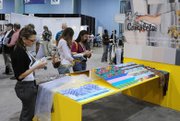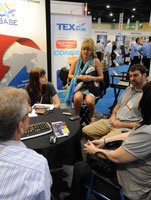Smaller Material World Show Yields Focused Buyers
MIAMI BEACH, Fla.—The April 21–23 run of the Material World & Technology Solutions expo was smaller in size, but buyers in the Miami Beach Convention Center during the 10th anniversary of the show were serious about products and services to help them emerge intact from the current economic crisis.
The show featured fabrics, technology and sourcing resources for designers, brands and retailers, with a strong representation from Latin America.
The footprint of the show was significantly smaller, with 300 booths, compared with more than 400 in recent shows, but most exhibitors weren’t complaining about the buyer attendance. Many said they stayed busy and saw waves of visitors.
“It was a lot better than I had anticipated,” said Alex Izmirlian, principal of Los Angeles–based printing-equipment supplier DigiFab.
For some, there was a renewed interest in Latin America sourcing as China continues to be challenged by rising costs and safety issues. Latin American manufacturing resources were in a good position to take away some business from Asia. Stores such as Target have already shifted some of their sourcing south of the border.
“Everybody is maintaining,” said Tony Malouf, sales manager with Guatemalan textile company Hilos y Telas S.A.
Consultant Walter Wilhelm of Salt Lake City–based Walter Wilhelm Associates, which had a booth at the show, said Latin America still has to upgrade its infrastructure to take full advantage of all that is in its favor. Officials from French technology company Lectra were in Wilhelm’s booth. The company recently announced that WWA will help with implementation and consulting for its PLM (product lifecycle management) suite, which manages pre-production via the Internet.
Chinese denim specialist Zibo Lanyan Group Co. Ltd. was also at the show, trying to grab a bigger piece of the American denim market. More than 70 percent of its business is with American brands, including Polo Ralph Lauren, The Children’s Place and others, said Manager Frank Liu.Finding growth in green
Many fabric companies reported continued interest in organics and eco-friendly materials. Jeff Reich of Fox-Rich Textiles, based in Ridgefield, Conn., said organics are the biggest growth area in the company.
“We’ve seen about 20 percent growth [in organic cottons] over the past three years,” he said. “We’re seeing a lot of start-up companies are focusing on it, as are companies that deal with baby products.”
Los Angeles–based Eclat Textiles was also touting green fabrics, showing a line of fabrics made with recycled PET bottles as well as organic bamboo and water-repellant fabrics.
“It’s big for the yoga market,” said representative April Booth. In addition, the company lowered its minimums to 500 yards to attract more customers. “Because stores are not giving much open-to-buy, the orders are smaller and less frequent,” she said.
The strategy is apparently working, according to Booth, who said company growth is up 5 percent.
Buyer Bojana Brown of knitwear producer MyWay (www.mywayinstyle.com) was scanning the show for light-gauge knits in silk and polyester for the e-commerce site’s Southeast customers. “I’m trying to find the threshold between the best prices and the best quality,” she said.Talking tech
Missing from the Technology Solutions section of the show were some past exhibitors, including Gerber Technology and Tukatech. Tukatech opted to show at the IMB show in Cologne, Germany, which took place at the same time, according to Chief Executive Officer Ram Sareen.
The exhibitors who did show tried to live up to the trade show’s name and provide solutions for the tough economy. One challenge has been higher barriers in credit markets. New York–based TradeCard was showing how its software can give smaller companies access to credit through its system, which facilitates all the steps involved in the financial supply chain.
“It’s back to the roots [of business] for everyone right now,” said Esther Lutz, TradeCard’s vice president of business development. “Everybody within the supply-chain network needs to work together. You have the people with the raw material on one end and the retailer on the other. There are a lot of speed bumps along the way. Everybody’s cutting back on purchasing, so you have to have the visibility, especially now.”
The absence of some tech vendors worked in the favor of other companies, such as New York–based OptiTex. “We’re the only CAD company here, so people are coming to us,” said Josh Scott, application specialist for OptiTex. The OptiTex booth was visited by many students, which didn’t bother Scott, who views them as future customers.
“For us, it’s amazing to see them so excited about 3-D and CAD,” he said. “They are not afraid of the technology. People are seeing the benefits and how it can save money.”
Vendors such as North Billerica, Mass.–based Arigo and St. Paul, Minn.–based Lawson Software used the show to unveil new products.
Arigo launched Arigo Collective, a visual-asset and content-management tool aimed at managing all the visuals and data assembled during the design process.
Lawson released an update of its Smart Office and launched Enterprise Search, a new product to search data across Lawson’s enterprise system and the user’s desktop, including personal history such as comments entered in Microsoft Office applications.
Material World will debut its West Coast version Sept. 30–Oct. 2 at the California Market Center in Los Angeles.























